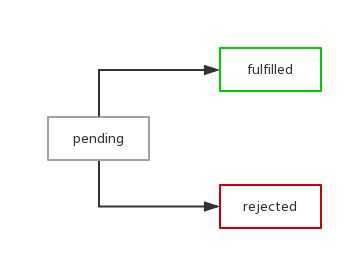标签:result 函数 text set lan user lang 情况下 val
1.promise常用方法
Promise.all() Promise.race() Promise.resolve() Promise.reject() Promise.prototype.catch() Promise.prototype.finally() Promise.prototype.then()
2.考虑下面一种获取用户id的请求处理
//例1
function getUserId() {
return new Promise(function(resolve) {
//异步请求
http.get(url, function(results) {
resolve(results.id)
})
})
}
getUserId().then(function(id) {
//一些处理
})getUserId方法返回一个promise,可以通过它的then方法注册(注意注册这个词)在promise异步操作成功时执行的回调。这种执行方式,使得异步调用变得十分顺手。
那么类似这种功能的Promise怎么实现呢?其实按照上面一句话,实现一个最基础的雏形还是很easy的。
this.then = function (onFulfilled) {
callbacks.push(onFulfilled);
return this;
};getUserId().then(function (id) {
// 一些处理
}).then(function (id) {
// 一些处理
});
function Promise(fn) {
var state = ‘pending‘,
value = null,
callbacks = [];
this.then = function (onFulfilled) {
if (state === ‘pending‘) {
callbacks.push(onFulfilled);
return this;
}
onFulfilled(value);
return this;
};
function resolve(newValue) {
value = newValue;
state = ‘fulfilled‘;
setTimeout(function () {
callbacks.forEach(function (callback) {
callback(value);
});
}, 0);
}
fn(resolve);
}function Promise(fn) {
var state = ‘pending‘,
value = null,
callbacks = [];
this.then = function (onFulfilled) {
return new Promise(function (resolve) {
handle({
onFulfilled: onFulfilled || null,
resolve: resolve
});
});
};
function handle(callback) {
if (state === ‘pending‘) {
callbacks.push(callback);
return;
}
//如果then中没有传递任何东西
if(!callback.onFulfilled) {
callback.resolve(value);
return;
}
var ret = callback.onFulfilled(value);
callback.resolve(ret);
}
function resolve(newValue) {
if (newValue && (typeof newValue === ‘object‘ || typeof newValue === ‘function‘)) {
var then = newValue.then;
if (typeof then === ‘function‘) {
then.call(newValue, resolve);
return;
}
}
state = ‘fulfilled‘;
value = newValue;
setTimeout(function () {
callbacks.forEach(function (callback) {
handle(callback);
});
}, 0);
}
fn(resolve);
}getUserId()
.then(getUserJobById)
.then(function (job) {
// 对job的处理
});
function getUserJobById(id) {
return new Promise(function (resolve) {
http.get(baseUrl + id, function(job) {
resolve(job);
});
});
}then方法中,创建并返回了新的Promise实例,这是串行Promise的基础,并且支持链式调用。handle方法是promise内部的方法。then方法传入的形参onFulfilled以及创建新Promise实例时传入的resolve均被push到当前promise的callbacks队列中,这是衔接当前promise和后邻promise的关键所在(这里一定要好好的分析下handle的作用)。getUserId生成的promise(简称getUserId promise)异步操作成功,执行其内部方法resolve,传入的参数正是异步操作的结果idhandle方法处理callbacks队列中的回调:getUserJobById方法,生成新的promise(getUserJobById promise)getUserId promise的then方法生成的新promise(称为bridge promise)的resolve方法,传入参数为getUserJobById promise。这种情况下,会将该resolve方法传入getUserJobById promise的then方法中,并直接返回。getUserJobById promise异步操作成功时,执行其callbacks中的回调:getUserId bridge promise中的resolve方法getUserId bridge promise的后邻promise的callbacks中的回调。//例5
function getUserId() {
return new Promise(function(resolve) {
//异步请求
http.get(url, function(error, results) {
if (error) {
reject(error);
}
resolve(results.id)
})
})
}
getUserId().then(function(id) {
//一些处理
}, function(error) {
console.log(error)
})有了之前处理fulfilled状态的经验,支持错误处理变得很容易,只需要在注册回调、处理状态变更上都要加入新的逻辑:
function Promise(fn) {
var state = ‘pending‘,
value = null,
callbacks = [];
this.then = function (onFulfilled, onRejected) {
return new Promise(function (resolve, reject) {
handle({
onFulfilled: onFulfilled || null,
onRejected: onRejected || null,
resolve: resolve,
reject: reject
});
});
};
function handle(callback) {
if (state === ‘pending‘) {
callbacks.push(callback);
return;
}
var cb = state === ‘fulfilled‘ ? callback.onFulfilled : callback.onRejected,
ret;
if (cb === null) {
cb = state === ‘fulfilled‘ ? callback.resolve : callback.reject;
cb(value);
return;
}
ret = cb(value);
callback.resolve(ret);
}
function resolve(newValue) {
if (newValue && (typeof newValue === ‘object‘ || typeof newValue === ‘function‘)) {
var then = newValue.then;
if (typeof then === ‘function‘) {
then.call(newValue, resolve, reject);
return;
}
}
state = ‘fulfilled‘;
value = newValue;
execute();
}
function reject(reason) {
state = ‘rejected‘;
value = reason;
execute();
}
function execute() {
setTimeout(function () {
callbacks.forEach(function (callback) {
handle(callback);
});
}, 0);
}
fn(resolve, reject);}
上述代码增加了新的reject方法,供异步操作失败时调用,同时抽出了resolve和reject共用的部分,形成execute方法。
错误冒泡是上述代码已经支持,且非常实用的一个特性。在handle中发现没有指定异步操作失败的回调时,会直接将bridge promise(then函数返回的promise,后同)设为rejected状态,如此达成执行后续失败回调的效果。这有利于简化串行Promise的失败处理成本,因为一组异步操作往往会对应一个实际功能,失败处理方法通常是一致的:
//例6
getUserId()
.then(getUserJobById)
.then(function (job) {
// 处理job
}, function (error) {
// getUserId或者getUerJobById时出现的错误
console.log(error);
});function handle(callback) {
if (state === ‘pending‘) {
callbacks.push(callback);
return;
}
var cb = state === ‘fulfilled‘ ? callback.onFulfilled : callback.onRejected,
ret;
if (cb === null) {
cb = state === ‘fulfilled‘ ? callback.resolve : callback.reject;
cb(value);
return;
}
try {
ret = cb(value);
callback.resolve(ret);
} catch (e) {
callback.reject(e);
}
}如果在异步操作中,多次执行resolve或者reject会重复处理后续回调,可以通过内置一个标志位解决。
标签:result 函数 text set lan user lang 情况下 val
原文地址:https://www.cnblogs.com/zhouyideboke/p/12875355.html